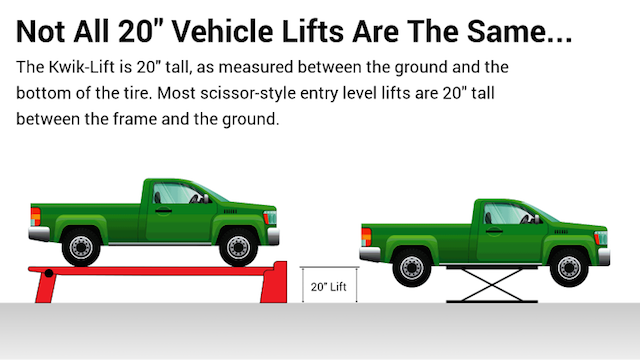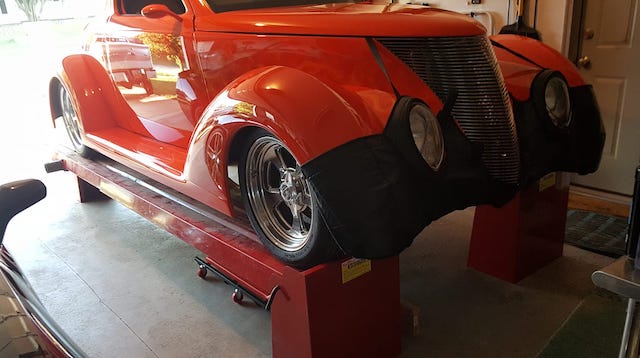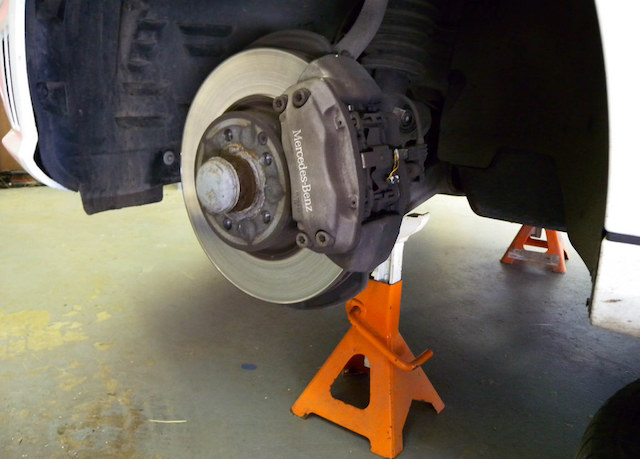
Looking for a car lift for your home garage that isn’t a commercial 2 post or 4 post hydraulic lift?
You’re in luck.
There are simpler, less complex lifts that offer a lot of the same capabilities.
The Trouble With 2 Post and 4 Post Hydraulic Car Lifts
While a lot of DIY auto enthusiasts say they want a commercial grade 2 post or 4 post lift, there are a few problems with these upgraded lifts:
- These lifts usually require a high garage ceiling. If you’ve got a garage with a height of 12 or 15 feet, great. If not, you’re either going to have trouble getting a lift into your garage, or your going to have to be very careful about how high you go.
- These lifts also typicially require a wider than average garage. It’s not just the additional height – it’s also the extra few feet of width these lifts need to operate. Again, if you’ve got an oversized garage – or you don’t mind losing a parking space – no problem.
- These lifts often require special electrical wiring and may require a new garage pad. Calling an electrician and pouring a new concrete floor can be required, depending on the lift you buy and your current garage specs. Typically, a commercial 2 post lift should be placed on a reinforced concrete pad that’s 4 inches thick. Some installers recommend 6 inches of thickness, only this recommendation has as much to do with local building codes as anything else.
- These lifts require maintenance. Last but not least, buying a 2 post or 4 post hydraulic lift means regular inspections of lift cables and periodic cable replacement, frequent lubrication, and (ideally) detailed inspections before every use. There’s also the possibility of hydraulic hardware failures that will cost a substantial sum to repair. Granted, all of these issues are minor if you invest in a good lift…but it’s one more thing you need to worry about.
- These lifts are expensive. A good quality 2 post or 4 post is not cheap. While you can find inexpensive lifts for as little $2,000, there is a reason for the price point – extremely cheap pumps, motors, hydraulics, thinner metal, smaller base plates, etc. You get what you pay for!
If you’re running an auto repair shop, the value of owning a commercial grade hydraulic lift is obvious. If you’re a DIY’er looking for a way to work on your vehicle in a standard home garage every now and then, a 2 post or 4 post lift might not be such a great idea.
If you fall into this latter group, here are four optoins to consider.
Oil Change Ramps
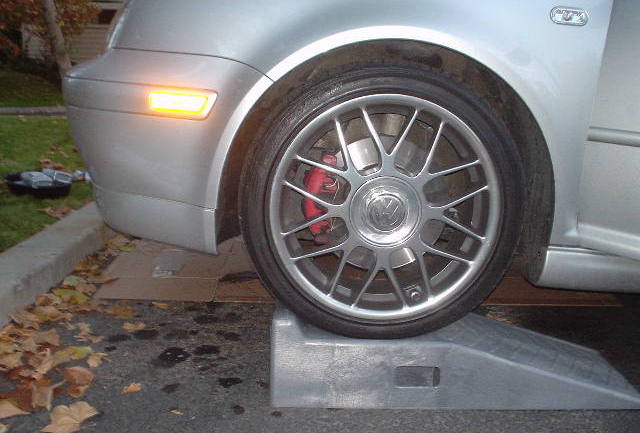
Oil change ramps are lightweight and usually made of resin. They’re designed to provide limited access to the underside of your vehicle’s engine, with just a few inches of lift. These are great for oil changes and other minor work but aren’t too helpful if you need to complete a major repair. They also don’t offer much help with access to the rest of your vehicle’s underside.
Pros: Low cost, lightweight, simple to use
Cons: Limited use; can slide on a smooth floor when you’re driving your car up onto them
Jack Stands
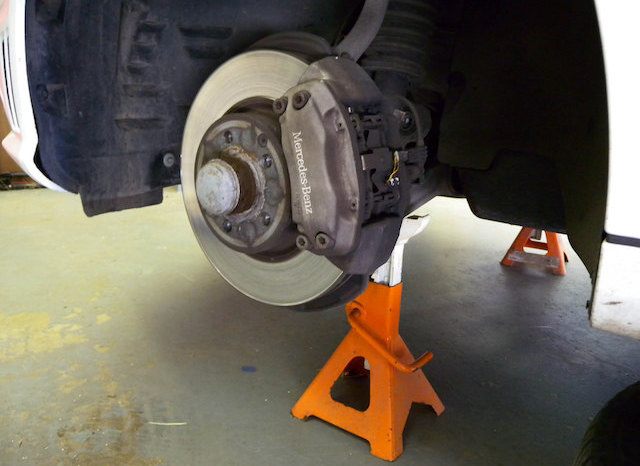
Another simple option, jack stands are heavy-duty steel rests that can support your vehicle in the air. In the “good old days,” jack stands were the only viable option available to DIY mechanics looking for a way to get their vehicle up in the air. Today, jack stands are definitely not the best option available to consumers.
Pros: Low cost
Cons: Safety problems are all too common; limited use; timely set up (finding the right jack points and getting to the correct height on all 4 corners of the car)
Entry-Level Scissor Style Hydraulic Lifts
You’ve seen or heard of these entry level lifts – they have clever names, offer gee-whiz functionality, and usually have some sort of scissor lift mechanism that relies on low-cost hydraulics.
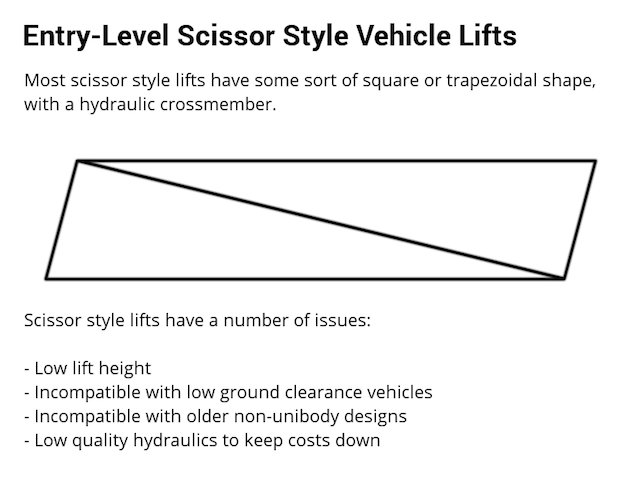
While these lifts are definitely cool, they have some serious issues:
- Most of these scissor style lifts require 4″ of ground clearance. If you’ve got a lowered vehicle – or just a car with low ground clearance, like a Corvette – you could find it very difficult to get one of these scissor style lifts under your vehicle
- Most scissor style lifts also have a hard time lifting vehicles with a long wheelbase. This is because these lifts only work between the wheels, and longer vehicles (like a newer Dodge Challenger) are often too big for this scissor style lift.
- Additionally, because most scissor style lifts operate between the front and rear wheels, they’re not stable when you have a vehicle with a major front or rear weight bias. If you’re doing a major overhall – say, an engine swap or axle replacement – your vehicle can tip forward or backward on one of these scissor style lifts.
- Scissor style lifts usually pick up a vehicle at pinch welds rather than designated jack points. Most of the time, this is not a problem. But if you have an older vehicle without designated jack points at the edges of the frame, it may not be possible to lift your vehicle with a scissor style lift.
- Last but not least, scissor style lifts usually don’t lift a vehicle very high into the air. Since scissor style lifts pick a vehicle up by it’s frame, they can’t usually create more than 18-24″ of space below the vehicle. This is plenty if you’re doing a quick brake job but not enough space to drop a transmission (or even to work comfortably if you have a car with low ground clearance). No one wants to work
“tip of nose to vehicle frame” if they don’t have to.
Additionally, these entry-level lifts often use the cheapest quality hydraulic systems. They leak, they fail much sooner than commercial grade lifts, and yet they cost nearly as much as a true commercial hydraulic lift.
Pros: They look cool
Cons: Doesn’t work well for vehicles with a low ground clearance, or a long wheelbase, or a substantial front/rear weight bias; Only 18-24″ of lift; Doesn’t work great for older vehicles that aren’t unibody; Cheap hydraulics that can leak or fail
The Kwik-Lift
Obviously, we’re biased in favor of the Kwik-Lift. Still, we think it beats anything but a 2 post or 4 post commercial lift. The Kwik-Lift offers:
- Nearly universal compaitbility, as the length of the Kwik-Lift and the distance between each side of the Kwik-Lift can be adjusted. The Kwik-Lift works great for a wide range of vehicles old and new.
- Because the Kwik-Lift supports a vehicle at the tires rather than the frame, there aren’t any issues with lifting older vehicles that don’t have outboard jack points.
- Excellent lift height, with most vehicles being 26″ to 28″ off the ground. This is just about the perfect height for use with a creeper.
- Works with extremely low ground clearance vehicles.
- Solid steel ramps are simple to operate, do not require complicated maintenance, and are rock solid in terms of safety. Kwik-Lift buyers report that the safety and security of the Kwik-Lift is second to none.
- Using a standard vehicle jack on either the ramp’s face or on the center lift bridge makes it easy to perform brake work, wheel hub replacement, etc.
- No hydraulics to fail or make a mess!
- The Kwik-Lift is easy to park on top of
- The Kwik-Lift offers true portability – you can quickly teardown the lift and set it to the side, and one person can easily move all the parts themselves
- The Kwik-Lift is made in the USA with US steel
Best of all, the Kwik-Lift always holds its value. If you decide to upgrade to a 2 post or 4 post lift someday, it’s easy to sell your Kwik-Lift for a good chunk of what you paid for it on Craigslist. The same can’t be said for entry-level hydraulic lifts, as people are (understandably) hesitant to buy used hydraulics.
Pros: Works with nearly any vehicle, even vehicles with very low ground clearance; Offers 26 to 28″ of lift; No hydraulics, no electricity, no complications; Safe and sturdy design; True portability; Park on top
Cons: No ‘fancy’ hydraulics
Summing Up
If you don’t have the room for a 2 post or 4 post lift – or if you just don’t want to mess with a big commercial vehicle lift – there are plenty of alternatives. Just be sure to understand the limitations of each lift option.

